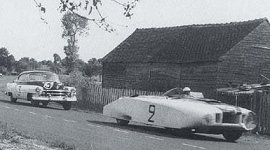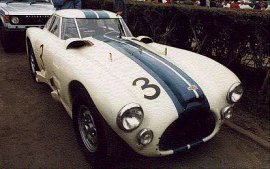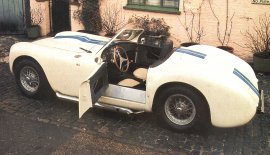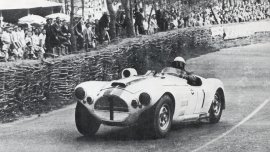 The
"Le Monstre" would remind you
of the saying “a face that only a
mother could love”....
The
"Le Monstre" would remind you
of the saying “a face that only a
mother could love”....
 A
Cunningham could easily be described
as a "bitsa", but what
wonderful bits were used! The C2R
featured a 220bhp version of the
Chrysler Hemi engine mated to a three-speed
Cadillac transmission... A
Cunningham could easily be described
as a "bitsa", but what
wonderful bits were used! The C2R
featured a 220bhp version of the
Chrysler Hemi engine mated to a three-speed
Cadillac transmission...
 The
Cunningham C2R of 1951 was one of
three cars entered into that years
event... The
Cunningham C2R of 1951 was one of
three cars entered into that years
event...
 The
1953 Cunningham 5.4 litre came as
a body dropped onto an engine/chassis
combination, with Pontiac usually
being the donor car... The
1953 Cunningham 5.4 litre came as
a body dropped onto an engine/chassis
combination, with Pontiac usually
being the donor car... |
To say Briggs Cunningham was an enigma
would be an understatement. Born in 1907, Cunningham
was a natural athlete excelling in everything from
bobsledding to golf and yachting – and in this latter sport
he even pulled off victory in the America’s
Cup.
After World War 2, Cunningham began racing
and tinkering with sports cars, once putting a Buick
engine in a Mercedes! He even went street racing
with his uncle in a Dodge tourer powered by a Hispano-Suiza
airplane engine.
Cunningham’s burning ambition
was to build American cars and have them driven by
American drivers in premier European motor-sport events.
His Holy Grail was naturally enough the Le Mans 24 hour
race, but Le Mans race regulations stated that prototypes
could only be entered by an established motorcar manufacturer.
Undaunted, in 1949 he hooked up with Phil Walters and
Bill Frick who had also experimented with engine swapping,
and in 1950 they formed Cunningham, Inc. With his newly formed company Cunningham was ready
to make his first assault at a Le Mans podium finish.
He entered 2 cars in the 1950 race, the first being
a standard bodied Cadillac two-door coupe that, much
to the amazement of both the crowd and commentators,
was to finish 10th. But it was his “Le Monstre”
entry which most people still remember.
The aptly named
“Le Monstre” was Cunninghams first-ever prototype sports car – although it shared much
in common with his other entry. Cunningham and his team
had simply removed the Cadillac body shell and draped
it in their own peculiar and rather ungainly version.
Dubbed the “C-1”, it would remind you of
the saying “a face that only a mother could love”.
He returned to Le Mans in 1951 with three race cars
and a spare of the new C-2R. This car had a massive
tubular chassis frame, independent front suspension,
de Dion rear suspension with inboard brakes, a 220bhp
version of the Chrysler Hemi engine, and a three-speed
Cadillac transmission. One of these cars was in second
place after 16 hours, but mechanical troubles then ensued,
and it could only finish eighteenth. The other cars
retired.
In 1952, one of his C4Rs driven by Cunningham himself
finished fourth, while in 1953 the same models achieved
seventh and tenth places. In the same year, however,
the new rigid-axled C-5 took third place.
His last Le
Mans attempt (in a Cunningham built car) was in 1954 when, once again with C4Rs, his cars achieved third
and fifth places. This was remarkable by any standards
(don't forget that a Ferrari won, and a Jaguar D-Type
came second), but it was still disappointing for a man
who always wanted to win outright.
It was during this period, while back on home soil,
that Cunningham’s new 'production line' produced
a series of 18 C-3 coupes. These cars all featured the
same basic mechanical design, though a semi-automatic
transmission was also optional, along with coupe bodywork by Vignale.
Though his cars were good, they were rather
more muscular and less polished than the competition,
and so Briggs Cunningham decided to switch to Jaguars
and, in 1962 at the age of 55, he finished 4th at Le
Mans in an XK-E. Cunningham would continue racing for
several more years, often using Jaguars painted white
with blue striping, but he never again produced his
own machines.
Today Briggs Cunningham is widely recognized as one
of the great patrons of sports car racing, providing
cars for Walters, John Fitch and Bill Spear in the early
days, then for Dan Gurney, Roger Penske, Bruce McLaren, Stirling Moss and others later on.
Sadly he passed away
in 2003, the same year that he was inducted into the
International Motorsports Hall of Fame.
Also see: Lost Marques - Cunningham (USA Edition) |



